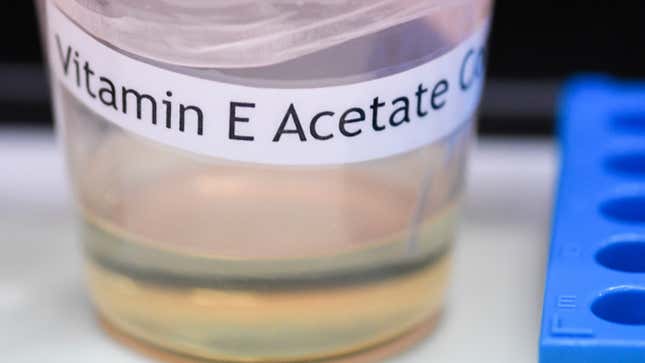
On Friday, federal health officials announced a breakthrough in solving the mystery of why people are getting seriously sick from vaping. They detected vitamin E acetate—an oily, synthetic form of the vitamin commonly added to black-market THC vape products—in lung fluid samples taken from all of the patients they’ve tested so far.
For months now, health officials and doctors have suspected that vitamin E acetate could be causing cases of the condition that’s now known as EVALI (e-cigarette, or vaping, product use associated lung injury). In the past, the inhalation of oils has been implicated as a rare cause of pneumonia. And tests of vaping products linked to cases of EVALI have found vitamin E acetate. But according to the Centers for Disease Control and Prevention, the evidence for its role up until this point had been entirely circumstantial.
During their press conference Friday, CDC officials unveiled the lab results of 29 patients with EVALI from across the country. All of their lungs showed the presence of vitamin E acetate, while other chemicals possibly found in vaping products that could have caused these injuries, such as plant or mineral oil, were nowhere to be seen.
“These findings provide direct evidence of vitamin E acetate at the primary site of injury within the lungs,” said Anne Schuchat, CDC’s principal deputy director, at the press conference. Later, when asked if these results represented a breakthrough in the investigation, Schuchat said yes.
The lab results also highlight the most common thread tying together patients with EVALI: a history of recently using THC vaping products. THC was found in 82 percent of the fluid samples, while nicotine was found in 62 percent of samples. Interestingly enough, THC was also found in three patients who reported they hadn’t used THC—supporting a theory that the minority of EVALI cases linked to the exclusive use of nicotine products may be even smaller than it seems. Currently, these cases represent about 11 percent of all EVALI patients.
Despite the results, though, CDC officials still aren’t ruling out that a small number of cases could have been caused by nicotine e-cigarettes. So for now, the agency continues to warn that people avoid all vaping and e-cigarette products and especially black-market THC products. Leaving aside e-cigarettes, it’s also likely that vitamin E acetate isn’t the only suspect chemical that could be behind EVALI. There may very well be other oily additives, and at least some doctors have failed to find any evidence of oil-caused pneumonia in their patients, indicating that other chemicals in these products could be damaging people’s lungs in a different way.
While newly reported cases of EVALI have started to slow in recent weeks, the outbreak doesn’t seem to be over. As of November 5, there have 2,051 EVALI cases reported to the CDC across 49 states, along with 39 deaths.